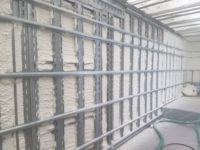Spray polyurethane foam insulation, also called spray foam, is an emerging technology that is regularly used in both residential and commercial construction. Spray foam is a two-component system that is spray applied as a liquid and expands in place to provide an insulation and air barrier in a single application. These products are plastic, so there is no food value for mold or mildew and they can assist earning points for sustainable programs due to their energy efficiency benefits and the use of renewable and recycled materials.
In the world of spray foam there are two categories of products: open-cell and closed-cell foam. Open-cell spray foams are also referred to as low-density, because they are typically less than one pound per cubic foot. These materials are semi-rigid, typically use water as the blowing agent, and achieve excellent sound attenuation properties. On the other hand, closed-cell foam includes an array of products used for interior and exterior insulation and roofing applications. This article will discuss a subset of the closed-cell foam market that is referred to as medium-density foam and is primarily used for interior and exterior insulation. These materials are rigid, have low vapor permeance properties and can be exposed to weather during a typical construction timeframe.
OPEN-CELL
Open cell products use water as the blowing agent, have R-values ranging from R-3.5 to R-4.5 per inch and have completed acoustic testing that offer sound ratings up to STC 52. Originally designed in Canada for use in bonus floor applications, over the past 20 years open-cell spray foam has expanded its reach into retrofit projects, custom homes, the production builder market and commercial construction. Open-cell foam is intended as cavity insulation inside exterior and interior walls, and for use in attics and crawlspaces. These products are not designed for structural use, are not flotation foams, and are not designed for contact with bulk water. If any of these concepts are design parameters, then closed-cell or medium-density foam is the product of choice.
CLOSED-CELL
In general, closed-cell foams are typically 1.7 to 2.5 pounds per cubic foot density and most use a zero-ozone depletion blowing agent called 245fa. The density and blowing agent has a direct affect on the R-value of spray foam and current R-values range from R-5.5 to R-7.4 per inch, depending on the thickness of the closed-cell foam. Closed-cell foam has also been tested to increase racking load for structural support, to increase up-lift loads for design in hurricane and tornado zones and as a water-resistive barrier. Furthermore, closed-cell foam can come in contact with the exterior elements and can be left exposed during a construction timeframe with no thermal degradation.
While closed-cell foam is regularly used in residential construction, for use as cavity wall insulation and in attics and crawlspaces, due to its versatility closed-cell foam is becoming integral to commercial building design. The fastest growing application for closed-cell foam is exterior encapsulations. Creating complete monolithic air and vapor control systems on the outside of buildings with no seams, no joints and no tape.
Closed-cell spray foam can serve as a five-in-one application, providing an exterior insulation, an air barrier, a vapor retarder, a drain plane and a water resistive barrier in a single application. The foam will often be the last phase before the façade goes up on the exterior of the building. This type of application also helps limit thermal bridging through structural members by providing continuous insulation and places most of a structure’s control layers (weather barrier, moisture barrier, air barrier, thermal boundary) on the exterior of the building.
COMPARING THE TWO PRODUCTS
Open-cell and closed-cell spray foam insulation products are regularly used on many different types of projects including commercial, residential and industrial, and on various substrates such as wood, metal and concrete. Spray foam is a very forgiving building product, allows for flexibility in design, and provides a solution for complicated situations. Considering the efficiency of designs using spray foam, the increasing demands of the energy code, including continuous insulation, and the capability to provide multiple control layers in a single application, both open-cell and closed-cell spray foam insulation will be in high demand as the construction industry continues to strive for energy excellence.
Comparing open-cell and closed-cell foam we find that both products are spray applied in a similar manner and use the same plural component proportioning equipment. They also both provide insulation and air barrier qualities in a single application. However, the differences are important to understand, especially when deciding which product is best for a specific application. While both products are spray applied, open-cell foam will expand over 100 times its liquid volume, whereas closed-cell foam will expand about 30 to 40 times its volume. This directly impacts minimum thicknesses of these products, so open-cell foam will typically be sprayed about 2½ to 3 inches minimum and closed-cell foam will be sprayed about 3/4 to 1 inch minimum. On the other hand, there are no maximum per pass thickness limits for open-cell foam but closed-cell foam, in general, is limited to about 2 inches per pass, and for greater total thicknesses, additional passes can be sprayed after a cool down period (refer to manufacturer data for limitations on specific products).
All in all, both open-cell and closed-cell foam belong to the same world of spray foam, and the primary difference between spray foam and traditional fibrous insulation is that spray foam adheres to the surface, expands in place and provides an insulation and air barrier in a single application. The foam expands to eliminate cracks, gaps and voids and creates a great fit each time, regardless of the size of the stud cavities. This results in tighter building envelopes, with reduced air leakage rates that will limit the impact of exterior contaminants (heat, moisture, allergens, etc.) on the inside of the thermal envelope.
The air barrier qualities of spray foam have created differentiation in the insulation market and have allowed advanced designs to be incorporated into building codes, including the unvented attic assembly, also called the closed attic assembly or the conditioned attic assembly. This design concept requires an air-impermeable insulation applied in direct contact with the roof deck, moving the thermal envelope from the attic floor to the roof, and allows the option to eliminate all ventilation, no soffit vents, gable vents, ridge vents or eave vents in the attic.
A few of the advantages of this design include lowering the building leakage rate by sealing vents in the roof, moving the mechanical system (i.e. ductwork and air handler) in the attic into semi-conditioned space and maintaining duct leakage within the thermal boundary. These variables combine to create a semi-conditioned attic space that typically maintains a temperature within 8 degrees to 12 degrees Fahrenheit of the living space and it may be no surprise that the unvented attic has been the most common application for spray foam in recent years. W&C









